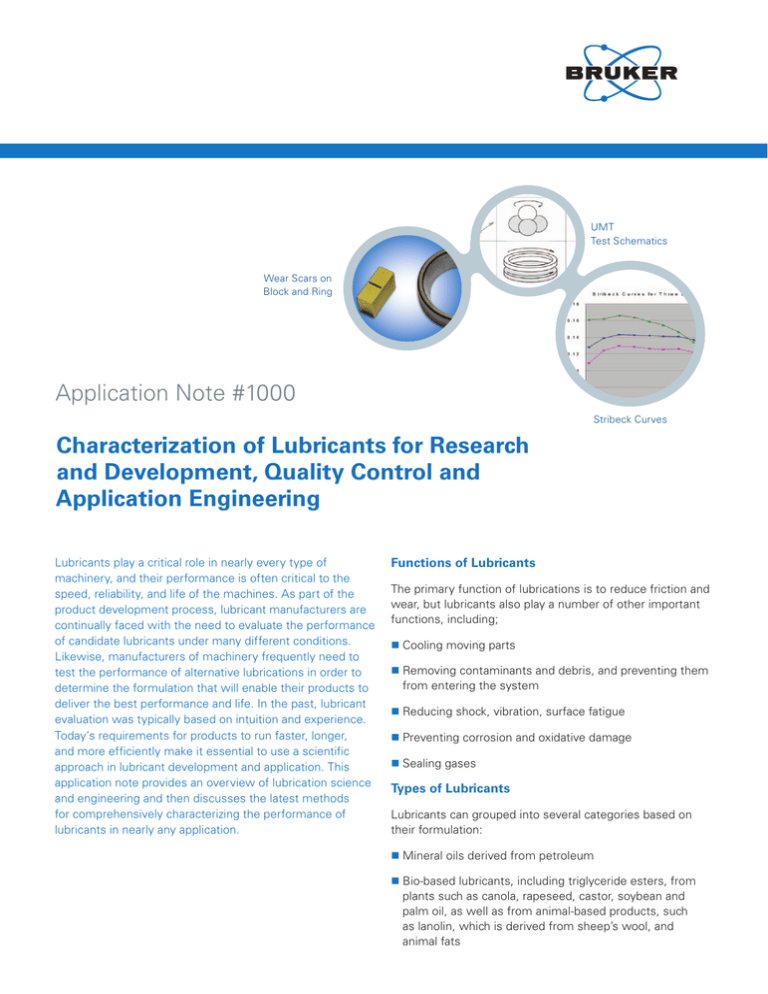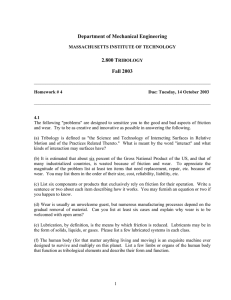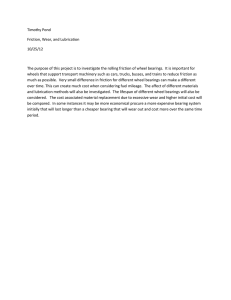
UMT
Test Schematics
Wear Scars on
Block and Ring
Application Note #1000
Stribeck Curves
Characterization of Lubricants for Research
and Development, Quality Control and
Application Engineering
Lubricants play a critical role in nearly every type of
machinery, and their performance is often critical to the
speed, reliability, and life of the machines. As part of the
product development process, lubricant manufacturers are
continually faced with the need to evaluate the performance
of candidate lubricants under many different conditions.
Likewise, manufacturers of machinery frequently need to
test the performance of alternative lubrications in order to
determine the formulation that will enable their products to
deliver the best performance and life. In the past, lubricant
evaluation was typically based on intuition and experience.
Today’s requirements for products to run faster, longer,
and more efficiently make it essential to use a scientific
approach in lubricant development and application. This
application note provides an overview of lubrication science
and engineering and then discusses the latest methods
for comprehensively characterizing the performance of
lubricants in nearly any application.
Functions of Lubricants
The primary function of lubrications is to reduce friction and
wear, but lubricants also play a number of other important
functions, including;
Cooling moving parts
Removing contaminants and debris, and preventing them
from entering the system
Reducing shock, vibration, surface fatigue
Preventing corrosion and oxidative damage
Sealing gases
Types of Lubricants
Lubricants can grouped into several categories based on
their formulation:
Mineral oils derived from petroleum
Bio-based lubricants, including triglyceride esters, from
plants such as canola, rapeseed, castor, soybean and
palm oil, as well as from animal-based products, such
as lanolin, which is derived from sheep’s wool, and
animal fats
Synthetic oils, such as poly-alpha olefin; synthetic-,
phosphate- and silicate-esters; alkylated naphthalene and
ionic fluids
however, damage during start and stop and vibration during
operation are potential dangers to be aware of with
this regime.
Solid lubricants, including polytetrafluoroethylene (PTFE),
graphite, Hexagonal Boron Nitride (HBN), MoS2, WS2; Cd,
Au, Pb, Sn, Zn, Cd and bronze
With hydrostatic lubrication, the two contacting surfaces
are again completely separated by a lubrication film. This
lubrication regime is similar to hydrodynamic lubrication
with the significant difference that the pressure is
generated by an external pump that maintains a continuous
supply of pressurized lubricant. Friction force is minimal at
a very slow sliding speed, making this type of lubrication
useful for precision control systems and other mechanisms
that operate at low speeds. A disadvantage of hydrostatic
lubrication is that the process depends upon the reliability
of the pump. The potential for damage to the bearing
surfaces exists if the pump fails.
Aqueous lubricants, such as brush polymers
(polyethylene glycol)
Lubrication Regimes
Lubrication processes show boundary, fluid
film (hydrodynamic and hydrostatic), and mixed
(elastohydrodynamic) regimes. In the first regime, called
boundary film lubrication, the load is carried by the surface
asperities rather than by the lubricant. In this regime, the
coefficient of friction is the ratio of the effective shear
stress and the plastic flow stress of the contact materials
and is typically in the range of 0.1 and higher. In other
words, the properties of the two mating surfaces play a far
more significant role than the lubricant. Lubricant additives
help reduce friction by forming a low-shear strength
interface between hard metal contacts. At relatively low
temperatures of 100°C to 150°C and pressures up to 1
GPa, friction can be minimized by covering the contacting
surfaces with adsorbed mono-molecular compounds, such
as fatty acids and Silane, that form a low shear-strength
layer that minimizes friction. At higher temperatures,
reactions between lubricant additives containing sulfur,
such as dibenzyl disulphide, chlorine or phosphorus, and
the metal surface result in the formation of sacrificial films
of inorganic materials. These films prevent metal-to-metal
contact and reduce wear. Lubrication under such conditions
depends on achieving a working temperature high enough
to form the film. The presence of oxygen and water can
also influence sacrificial film formation.
In both the hydrodynamic and hydrostatic lubrication
regimes, the load is carried entirely by the lubricating
film. With hydrodynamic lubrication, the two contacting
surfaces are completely separated by a film of lubricant
that reduces friction and wear. The coefficient of friction is
maintained at a very low level of about 0.005 and is due
only to the shearing of the fluid. Under these conditions,
failure brought about by friction rarely occurs. There are two
necessary conditions to achieve hydrodynamic lubrication.
Relative motion between the two contacting surfaces must
be maintained with sufficient velocity to generate a loadcarrying lubricating film. In addition, the surfaces must form
a converging gap into which the fluid is drawn to create a
pressure field to support the load, and separate the solid
surfaces. Any liquid or gas can be used as the lubricant
in this regime, provided that its viscosity is appropriate
for the load and speed, with the caveat that it should not
react chemically with the bearing surfaces. Hydrodynamic
lubrication is the preferred form of lubrication in most
bearing systems, piston/liner assemblies and so on,
2
In the elastohydrodynamic regime, elastic deformation
of the asperity contacts enlarges the load-bearing area to
the point that the viscous resistance of the lubricant helps
support the load. The very thin 0.1µm to 1µm lubricating
film separates the contacting surfaces, reducing friction
and wear. The contacting surfaces deform elastically due
to the presence of hydrodynamic pressure in the film.
Elastohydrodynamic lubrication involves a rapid change in
the lubricant properties from nearly an ideal liquid state
outside the contact zone to an extremely viscous solid-like
state within the contact zone. Mineral and synthetic oils are
primarily used for elastohydrodynamic lubrication because
they exhibit pressure-dependent viscosity, also known as
piezo-viscosity.
Stribeck curve.
Mixed lubrication is the regime where the conditions are
between hydrodynamic and boundary, either because the
viscosity or velocity are too low, or the load is too high to
permit complete separation of the surfaces.
The Stribeck curve shows friction as a function of viscosity,
speed and load. The vertical axis depicts the coefficient of
friction (COF) and the horizontal axis plots a dimensionless
parameter that combines viscosity, speed and load
ηV
Fz
where η is the viscosity of the lubricant, V is the sliding
velocity and Fz is the normal load. This curve can be used to
determine the optimal speed for the lubricated contact that
minimizes the coefficient of friction.
Lubricant testing can be performed on a variety of
tribometers, each addressing a particular lubrication regime.
Bruker‘s UMT Nano+Micro Tribometer is designed to
provide comprehensive materials testing for mechanical
and tribological properties with a load range of 1mN to 200
N. Interchangeable lower and upper drives perform rotary,
reciprocating and block-on-ring tests using the same tool.
All motions are independently programmable for custom
wear tracks. Automatic COF versus load and velocity curves
are generated to provide the tribological finger print. The
UMT is capable of performing ISO, ASTM and DIN tests,
is available with environmental chambers, and is able to
monitor and record in situ acoustic emission, electrical data,
friction, wear, down force, temperature, humidity, etc.
Reciprocating Test
Reciprocating tests, including ball-on-plate and pin-on-plate,
can be performed by installing a plate inside the liquid
holder on the test machine. The piston ring-on-cylinder test
(ASTM G181) can also be performed with this setup. Fx and
Fz data are measured to obtain the COF. The reciprocating
test can be used to perform the following ASTM standard
tests: D5706: Extreme Pressure Properties of Lubricating
Greases, D5707: Friction and Wear Properties of Lubricating
Grease and D2981: Test Method for Solid Lubricants in
Oscillating Motion.
Rotary Test
In the rotary test, a ball or pin is installed under the load
sensor and a standard disk is installed inside a liquid holder.
During the test Fx and Fz are measured to obtain the COF.
This test setup can be used to perform ASTM standard
tests, including test for low temperature torque of ballbearing grease. It can also be used to produce a Stribeck
curve. Electrical contact resistance and acoustic emissions
can be monitored, and the test can be performed at
ambient or elevated temperatures.
Reciprocating test module.
Disk-on-Disk Test
Disk-on-disk tests can be used to simulate the operation
of a clutch with rotary motion. A disk is installed inside
the liquid holder. Fx (converted from torque) and Fz data
are measured to obtain the COF. The ring-on-disk (thrust
washer) test can also be performed in this module.
Rotary test module.
Disk-on-disk test module.
3
Block-on-Ring Test
In the block-on-ring test a block is loaded from the top and
pressed against a rotating ring. A block holder is used to
hold the block. A standard ring is installed on the arbor,
which rotates in the horizontal axis. Fx and Fz data are
measured to obtain the COF. The block’s wear scar can be
measured with a 3D microscope as shown below.
groove. This setup can be used to perform several ASTM
standard tests.
The ASTM D3233 test begins with a run-in for 5 minutes
at 1174 N load and 290 rpm. The load is then raised to 1832
N and the test is run for 1 minute at 290 rpm. The load is
raised to 2828 N for 1 minute, to 3824 N for 1 minute, and
then raised in a similar progression until the lubricant fails.
Failure of the oil is detected by a sharp increase of friction.
Piston Ring-on-Cylinder Liner Test
The friction of piston ring and cylinder liner materials under
lubricated conditions can be determined as per ASTM G181.
The loading is increased from 20 N to 200 N in increments
of 20 N with holding time at each load of 1 minute. The
materials are then unloaded from 200 N to 20 N in 20 N
increments with a holding time of 1 second at each step.
The test is carried out with a temperature of 100 ± 2°C,
stroke of 10 mm and frequency of 10 Hz. The average value
of friction during loading and unloading corresponding to
the same load is reported as a function of load.
Block-on-ring test module.
The results of a piston ring-on-cylinder liner friction test per
ASTM G181 with two different lubricants is shown below.
Lubricant A (red) showed a higher COF at every load but
also a lower increase in COF over the test range. Lubricant
B (blue) exhibited a lower COF and a rise in friction with
the increase of load due to change toward a boundary film
regime at higher loads.
Depth profile of wear scar in block-on-ring test.
Pin and Vee Test
The pin-on-vee block test is performed by rotating a pin
and loading it so that it is forced down against a vee
ASTM D3233 test results using pin-and-vee method.
4
Piston ring-on-cylinder linear test results.
Four-Ball Test
Sliding-to-Rolling Ratios
This test is performed with the UMT using a 4-ball test
setup with the rotary drive in a heating chamber at a fixed
temperature of 75°C as per the ASTM D4172 standard test
method. SAE 52100 balls with 0.5 inch diameter are used.
Three balls are assembled inside a ball holder with a liquid
reservoir. The test lubricant is poured inside the ball holder.
The fourth ball engages from the top at the center of the
three balls with a load of 392 N. The liquid holder with three
balls rotates at 1200 rpm for 1 hour. A torque sensor is used
to measure friction and normal force to calculate COF. After
the test, the wear scars on all three balls are measured and
average wear scar diameter value is reported. The smaller
the wear scar diameter, the better is the performance of
the lubricant.
Rotary and reciprocating tests can be performed at various
sliding-to-rolling ratios. The tribometer can be set up for
sliding-to-rolling ratios in rotary motion as follows:
0% sliding when three balls are used
15% sliding when three short rollers are used
35% sliding when three long rollers are used
65% sliding when three long rollers are installed on three
slanted slots
6D Sensor
Twist Compression Test
Rigid Adapter
The twist compression test is primarily used to evaluate
cutting fluid used in metal cutting operations as well as
sheet metal lubricants. It simulates the action of the flute
of the tool on the workpiece. The friction torque plot usually
exhibits four distinct stages: initial break-in (I), effective
lubrication (II), depletion of lubricant (III), and failure of
lubricant (IV). The time taken for Tz and acoustic emissions
(AE) to rise due to the failure of the lubricant is reported as
the durability of the lubricant.
Self-leveling Holder
Loading Plate
Upper Disk
Bearing Cage
Rollers
Lower Disk
Liquid Holder
Bearing Cage
Rollers
Liquid Holder
Configuring sliding to rolling ratios for rotary motion.
Conclusion
Typical twist compression test plots.
For comprehensive tribological characterization, lubricants
need to be tested and compared under different
lubrication regimes, loads, speeds, sliding-to-rolling ratios,
temperatures and humidity levels. The UMT provides an
ideal platform for performing standard and customized tests
to accurately and efficiently characterize the tribological
properties of lubricants as part of the development, quality
control and applications processes. Even when in-situ
testing in actual machine components is preferred, the UMT
can be used to conduct screening tests on the candidate
materials, allowing users to eliminate unsuitable lubricants
or materials quickly. Comprehensive data gathering and
rapid screening allow users to develop superior lubricants in
a very efficient manner.
5
Authors
James Earle, Bruker Nano Surfaces Division
james.earle@bruker-nano.com
Suresh Kuiry, Ph.D., Bruker Nano Surfaces Division
Bruker Nano Surfaces Division
Campbell, CA • USA
Phone +1.408.376.4040/866.262.4040
productinfo@bruker-nano.com
www.bruker.com
6
©2012 Bruker Corporation. All rights reserved. All trademarks are the property of their respective companies. AN1000, Rev. B0
UMT System.
Bruker Nano Surfaces Division is continually improving its products and reserves the right to change specifications without notice.
suresh.kuiry@bruker-nano.com




